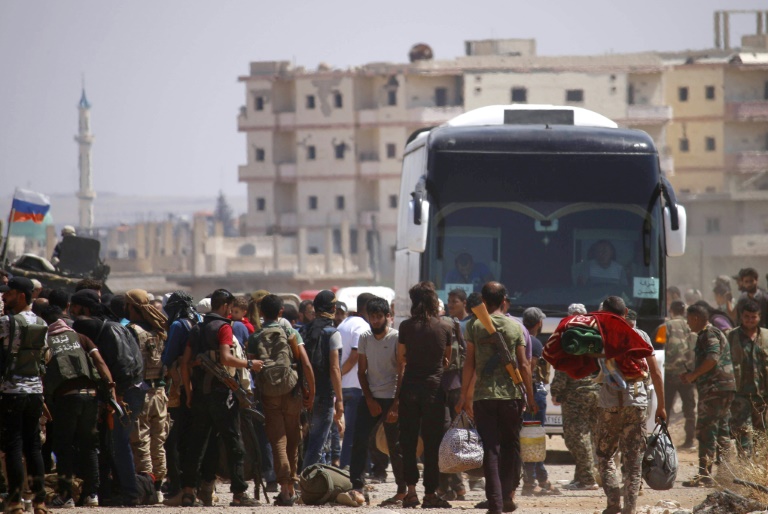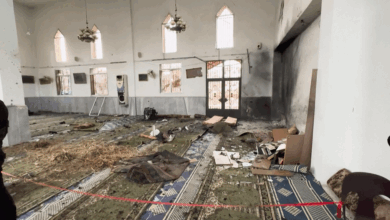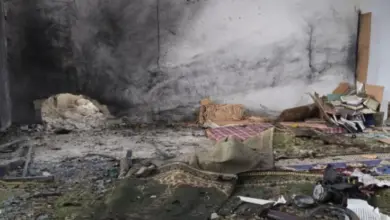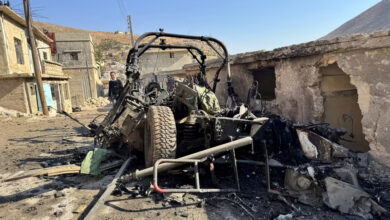
A deal was reached on Tuesday for the evacuation of two pro-regime towns in Syria, allowing thousands to leave after three years of encirclement by hardline rebels.
Fuaa and Kafraya are the last remaining towns under siege in Syria, where the medieval tactic was mostly made notorious by government forces in the seven-year war.
Surrounded and bombed by hostile factions, the Shiite-majority towns became both a rallying cry for the government and a playing card in callous rebel hands.
Their residents are all expected to leave under a major agreement reached Tuesday between government ally Moscow and rebel backer Ankara, a war monitor said.
“The deal provides for the total evacuation of residents in the two towns, which are besieged by rebels and Hayat Tahrir al-Sham, to regime territory in nearby Aleppo province,” said the Syrian Observatory for Human Rights.
Hayat Tahrir al-Sham, or HTS, is a jihadist alliance led by Al-Qaeda’s former affiliate in Syria.
Hundreds of people would be released from the regime’s notorious detention centres in exchange, Observatory head Rami Abdel Rahman told AFP.
A source from HTS also confirmed the deal, telling AFP that more than 100 buses would evacuate 6,900 people including fighters and civilians from Fuaa and Kafraya.
The source said 1,500 people would be freed from government-run jails.
The agreement has not been confirmed by any government involved, but Syrian state media reported Tuesday that it had preliminary information on a deal to free “thousands” of people from Fuaa and Kafraya.
‘Haven’t forgotten’
The towns came under siege in 2015, as rebels and jihadists overran the surrounding province of Idlib.
That cut off access to food and medicine for their residents outside of United Nations aid deliveries.
The evacuation deal reached Tuesday is not the first for the two tiny towns.
In April 2017, thousands were bussed out Fuaa and Kafraya in exchange for parallel evacuations from two towns near Damascus that were being besieged by the government.
But a blast targeting a convoy of evacuees from Fuaa and Kafraya left 150 people dead, most of them civilians and including 72 children.
Traumatized residents left behind are now afraid that scenario might happen again.
“What are we going to do with our land and property? Oh my hometown,” said a 42-year-old resident of Kafraya who spoke on condition of anonymity.
“I pray this will go well — we still haven’t forgotten those that died in the blast,” he told AFP on Tuesday.
Syria’s conflict erupted in March 2011 with protests against President Bashar al-Assad that later spun out into full-fledged war.
Early on in the uprising, Turkey began providing support to rebel groups as Russia and Iran steadfastly backed their man in Damascus.
Those three countries have become the main powerbrokers in Syria, agreeing last year to create four “de-escalation” zones to pave the way for a nationwide ceasefire.
Idlib is part of one such zone. It borders Turkey to the northwest but is otherwise almost totally surrounded by regime territory, prompting fears the government would eventually attack it.
No Idlib attack?
But the Observatory said the terms of the new Russia-Turkey deal included keeping the regime from waging a military operation there.
The Britain-based monitor said Turkish and Russian forces would also jointly patrol a part of the key M5 highway which cuts through Idlib.
The M5 connects Damascus to second city Aleppo in the north.
Analyst Nawar Oliver at the Turkey-based Omran Centre said the evacuation could pave the way for a grand bargain on Idlib.
“Change is inevitably coming to Idlib, but There are numerous predicaments that need to be resolved, including Fuaa and Kafraya, before reaching a final deal,” Oliver told AFP.
Assad’s forces have already recaptured two of the “de-escalation” zones this year: Eastern Ghouta outside Damascus and an area in central Homs.
They sealed their control over those areas with a blend of military pressure and negotiated surrenders of rebel groups there.
Using the same tactics, they are now close to seizing the third zone in southern Syria, which includes the key provinces of Daraa and Quneitra.
Heavy air strikes on Tuesday battered an area straddling the two governorates, killing 15 civilians across two towns, according to the Observatory.
Tens of thousands of civilians remain displaced in a part of Quneitra just a handful of kilometres (miles) from the Israeli-occupied Golan Heights.
But Israel, like Jordan to Syria’s south, has kept the border closed to desperate displaced families fleeing the assault in recent weeks.




